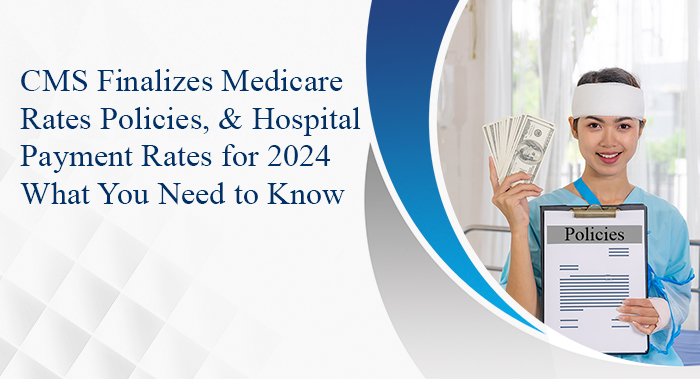
CMS Finalizes Medicare Rates, Policies, and Hospital Payment Rates for 2024: What You Need to Know
The Centers for Medicare & Medicaid Services (CMS) issued the final rule on August 1, 2023, for the fiscal year (FY) 2024 Medicare hospital inpatient prospective payment system (IPPS) and long-term care hospital prospective payment system (LTCH PPS). As a healthcare associate, it’s crucial to be aware of CMS Physician Final Rules for 2024 in order to provide quality treatment or healthcare services.
This final rule encompasses updates to payment rates and policies for Medicare fee-for-service inpatient hospitals and LTCHs for FY 2024. The issuance of this final rule is in compliance with the mandatory annual review and adjustment of Medicare payment policies for IPPS hospitals and LTCHs as per legal requirements. Notably, CMS has integrated policies in this final rule aimed at advancing health equity and enhancing patient safety.
Furthermore, this rule consolidates and confirms the proposals initially outlined in CMS-1788-P, specifically addressing the considerations surrounding the treatment of Section 1115 demonstration days in the computation of Medicare disproportionate share hospital (DSH) payments.
IPPS AND LTCH PPS
CMS provides compensation to acute care hospitals for their inpatient care services through the Inpatient Prospective Payment System (IPPS). Long-term care hospitals (LTCHs) receive payments through the Long-Term Care Hospital Prospective Payment System (LTCH PPS). These payment frameworks are designed to establish predetermined base payment rates for inpatient care, generally contingent on factors such as the patient's diagnosis, the services or treatments rendered, and the severity of the illness. Each hospital is allocated a singular payment for each case, depending on the payment category assigned at the point of discharge. These categories are specified as follows: for IPPS, they are known as Medicare Severity Diagnosis-Related Groups (MS-DRGs), and for LTCH PPS, they are designated as Medicare Severity Long-Term Care Diagnosis-Related Groups (MS-LTC-DRGs).
In accordance with legal mandates, CMS is obligated to update the payment rates for IPPS hospitals annually. This update must account for changes in the prices of goods and services employed by these hospitals in the treatment of Medicare patients, as well as other relevant factors. The method employed for this purpose is referred to as the IPPS Hospital Market Basket. The IPPS remunerates hospitals for services rendered to Medicare beneficiaries using a national base payment rate, which is adjusted to consider several cost-influencing factors, such as the patient's medical condition and the labor costs specific to the hospital's geographic area. In parallel, CMS also revises the payment rates for LTCHs on an annual basis, using a separate market basket that is tailored to the unique goods and services relevant to long-term care hospitals.
What are the Changes to Payment Under IPPS
The payment rate increase for general acute care hospitals under the IPPS, which participate in the Hospital Inpatient Quality Reporting program and use electronic health records meaningfully, will be 3.1% in FY 2024. This increase is derived from a projected 3.3% market basket update, as well as a mandated 0.2% productivity adjustment. This update accounts for changes in various cost factors, including expected increases in compensation.
The overall effect of these changes will result in a $2.2 billion increase in hospital payments in FY 2024. However, Medicare disproportionate share hospital (DSH) payments and Medicare uncompensated care payments are projected to decrease by approximately $957 million in FY 2024 due to updated estimates and data. Furthermore, additional payments for inpatient cases involving new medical technologies are expected to decrease by $364 million in FY 2024, primarily due to the expiration of new technology add-on payments for several technologies.
What are the Changes to Payment Under LTCH PPS
In the CMS Physician Final Rules for 2024, CMS anticipates some noteworthy changes in payments for Long-Term Care Hospitals (LTCHs). The standard payment rate for LTCHs is set to increase by 3.3%. Additionally, LTCH PPS payments for discharges, which fall under the LTCH standard payment rate, are expected to see a modest increase of about 0.2%, equivalent to $6 million. This growth is mainly due to a projected 2.9% reduction in high-cost outlier payments as a portion of total LTCH PPS standard federal payment rate payments.
But what really caught our attention is that CMS has been responsive to public feedback. They've fine-tuned the method for establishing the LTCH PPS high-cost outlier threshold for discharges under the LTCH standard federal payment rate. The finalized threshold is noticeably lower than what was initially proposed. This means that the system has been adjusted to better account for exceptional cases, potentially bringing cost savings and better healthcare financing for LTCHs.
What Changes are in the Health Equity Policies
In the final rule, CMS is currently reviewing feedback on challenges faced by safety-net hospitals. They're exploring how to identify and categorize these hospitals and considering the "area deprivation index" as a measure.
CMS has officially changed the designation of homelessness diagnosis codes to a higher severity level for FY 2024. This recognizes homelessness as a factor contributing to increased resource utilization in hospitals.
For FY 2024, CMS has earmarked approximately $1.7 billion for value-based incentive payments. They've also updated the scoring methodology, introduced a Health Equity Adjustment, and made changes to efficiency measurement tools.
In the Hospital VBP program, CMS has adopted a standard procedure for sepsis care and introduced changes to the survey process for the Hospital Consumer Assessment of Healthcare Providers and Systems. These changes will take effect in January 2025.




